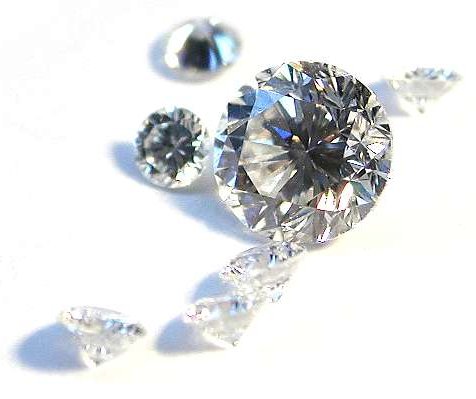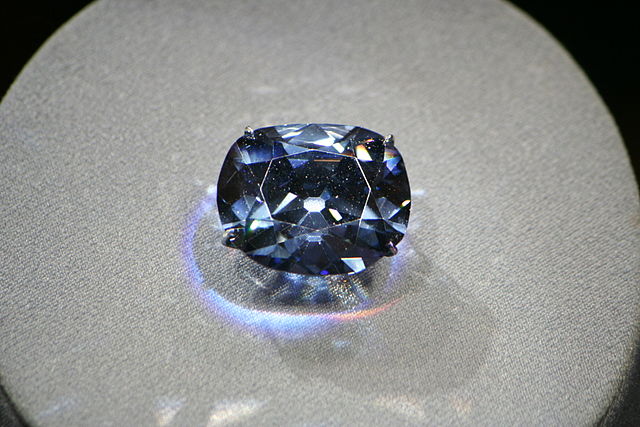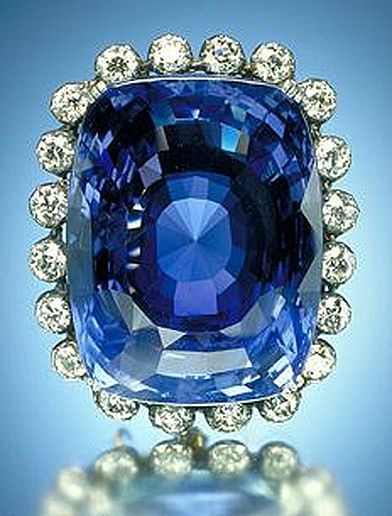Difference between revisions of "Diamond"
Occultwiki (talk | contribs) (Created page with "350px|thumb|Group of cut diamonds '''Diamond''' is a solid form of the element carbon with its atoms arranged in a crystal structure called diamond c...") |
Occultwiki (talk | contribs) |
||
| Line 1: | Line 1: | ||
[[File:Cut Diamonds.jpg|350px|thumb|Group of cut diamonds]] | [[File:Cut Diamonds.jpg|350px|thumb|Group of cut diamonds]] | ||
'''Diamond''' is a solid form of the element carbon with its atoms arranged in a crystal structure called diamond cubic. Diamond as a form of carbon is a tasteless, odourless, strong, brittle solid, colourless in pure form, a poor conductor of electricity, and insoluble in water. | '''Diamond''' is a solid form of the element carbon with its atoms arranged in a [[crystal]] structure called diamond cubic. Diamond as a form of carbon is a tasteless, odourless, strong, brittle solid, colourless in pure form, a poor conductor of electricity, and insoluble in water. | ||
Diamond has the highest hardness and thermal conductivity of any natural material, properties that are used in major industrial applications such as cutting and polishing tools. | Diamond has the highest hardness and thermal conductivity of any natural material, properties that are used in major industrial applications such as cutting and polishing tools. | ||
| Line 18: | Line 18: | ||
==Color== | ==Color== | ||
[[File:Hope Diamond.jpg|350px|thumb|The Hope Diamond, a blue diamond believed to be the subject of a curse.]] | [[File:Hope Diamond.jpg|350px|thumb|The Hope Diamond, a blue diamond believed to be the subject of a curse.]] | ||
Pure diamond should transmit visible light and appear as a clear colorless crystal. Colors in diamond originate from lattice defects and impurities. Nitrogen is by far the most common impurity found in gem diamonds and is responsible for the yellow and brown color in diamonds. Boron is responsible for the blue color. | Pure diamond should transmit visible light and appear as a clear colorless [[crystal]]. Colors in diamond originate from lattice defects and impurities. Nitrogen is by far the most common impurity found in gem diamonds and is responsible for the yellow and brown color in diamonds. Boron is responsible for the blue color. | ||
In order of increasing rarity, yellow diamond is followed by brown, colorless, then by blue, green, black, pink, orange, purple, and red. "Black", or carbonado, diamonds are not truly black, but rather contain numerous dark inclusions that give the gems their dark appearance. | In order of increasing rarity, yellow diamond is followed by brown, colorless, then by blue, green, black, pink, orange, purple, and red. "Black", or carbonado, diamonds are not truly black, but rather contain numerous dark inclusions that give the gems their dark appearance. | ||
| Line 45: | Line 45: | ||
==Occult properties== | ==Occult properties== | ||
Although [[quartz]] | Although [[quartz]] [[crystal]]s are the most common clear gemstone used in [[ritual magic]], diamonds also have esoteric properties. | ||
According to [[Heinrich Cornelius Agrippa]], diamonds fall under the rulership of the planet [[Mars]], and also very strongly under the star Agol. Because of its connection to Mars, and thus the element of iron, the presence of diamonds will negate the properties of lodestone and the two minerals should not be placed near each other during magical workings. ''[[Three Books of Occult Philosophy]]'' states that diamonds may be used to bind or otherwise contain [[demon]]s, [[angel]]s, and other spirits related to the planet Mars. | According to [[Heinrich Cornelius Agrippa]], diamonds fall under the rulership of the planet [[Mars]], and also very strongly under the star Agol. Because of its connection to Mars, and thus the element of iron, the presence of diamonds will negate the properties of lodestone and the two minerals should not be placed near each other during magical workings. ''[[Three Books of Occult Philosophy]]'' states that diamonds may be used to bind or otherwise contain [[demon]]s, [[angel]]s, and other spirits related to the planet Mars. | ||
Revision as of 15:47, 13 November 2024
Diamond is a solid form of the element carbon with its atoms arranged in a crystal structure called diamond cubic. Diamond as a form of carbon is a tasteless, odourless, strong, brittle solid, colourless in pure form, a poor conductor of electricity, and insoluble in water.
Diamond has the highest hardness and thermal conductivity of any natural material, properties that are used in major industrial applications such as cutting and polishing tools.
Properties
Most natural diamonds have ages between 1 billion and 3.5 billion years. Most were formed at depths between 150 and 250 kilometres (93 and 155 mi) in the Earth's mantle, although a few have come from as deep as 800 kilometres (500 mi).
Diamonds have been adopted for many uses because of the material's exceptional physical characteristics. It has the highest thermal conductivity and the highest sound velocity. It has low adhesion and friction, and its coefficient of thermal expansion is extremely low. Its optical transparency extends from the far infrared to the deep ultraviolet and it has high optical dispersion. It also has high electrical resistance. It is chemically inert, not reacting with most corrosive substances, and has excellent biological compatibility.
Hardness
The hardness of diamond contributes to its suitability as a gemstone. Because it can only be scratched by other diamonds, it maintains its polish extremely well. Unlike many other gems, it is well-suited to daily wear because of its resistance to scratching—perhaps contributing to its popularity as the preferred gem in engagement or wedding rings, which are often worn every day.
The hardest natural diamonds mostly originate from the Copeton and Bingara fields located in the New England area in New South Wales, Australia.
Diamonds cut glass, but this does not positively identify a diamond because other materials, such as quartz, also lie above glass on the Mohs scale and can also cut it. Diamonds can scratch other diamonds, but this can result in damage to one or both stones.
Color
Pure diamond should transmit visible light and appear as a clear colorless crystal. Colors in diamond originate from lattice defects and impurities. Nitrogen is by far the most common impurity found in gem diamonds and is responsible for the yellow and brown color in diamonds. Boron is responsible for the blue color.
In order of increasing rarity, yellow diamond is followed by brown, colorless, then by blue, green, black, pink, orange, purple, and red. "Black", or carbonado, diamonds are not truly black, but rather contain numerous dark inclusions that give the gems their dark appearance.
Geology and distribution
Diamonds are extremely rare, with concentrations of at most parts per billion in source rock. Before the 20th century, most diamonds were found in alluvial deposits. Loose diamonds are also found along existing and ancient shorelines, where they tend to accumulate because of their size and density. Rarely, they have been found in glacial till (notably in Wisconsin and Indiana), but these deposits are not of commercial quality. These types of deposit were derived from localized igneous intrusions through weathering and transport by wind or water.
Roughly 49% of diamonds originate from Central and Southern Africa, although significant sources of the mineral have been discovered in Canada, India, Russia, Brazil, and Australia. They are mined from kimberlite and lamproite volcanic pipes, which can bring diamond crystals, originating from deep within the Earth where high pressures and temperatures enable them to form, to the surface.
In some of the more politically unstable central African and west African countries, revolutionary groups have taken control of diamond mines, using proceeds from diamond sales to finance their operations. Diamonds sold through this process are known as "conflict diamonds" or "blood diamonds."
Extraterrestrial diamonds
Although diamonds on Earth are rare, they are very common in space. In meteorites, about three percent of the carbon is in the form of nanodiamonds, having diameters of a few nanometers. Sufficiently small diamonds can form in the cold of space because their lower surface energy makes them more stable than graphite. The isotopic signatures of some nanodiamonds indicate they were formed outside the Solar System in stars.
High pressure experiments predict that large quantities of diamonds condense from methane into a "diamond rain" on the ice giant planets Uranus and Neptune. Some extrasolar planets may be almost entirely composed of diamond.
Diamonds may exist in carbon-rich stars, particularly white dwarfs. One theory for the origin of carbonado, the toughest form of diamond, is that it originated in a white dwarf or supernova. Diamonds formed in stars may have been the first minerals.
History of human use
The name diamond is derived from Ancient Greek: ἀδάμας (adámas), 'proper, unalterable, unbreakable, untamed'.
Diamonds are thought to have been first recognized and mined in India, where significant alluvial deposits of the stone could be found many centuries ago along the rivers Penner, Krishna, and Godavari. Diamonds have been known in India for at least 3,000 years but most likely 6,000 years.
Diamonds have been treasured as gemstones since their use as religious icons in ancient India. Deceiving others with synthetic diamonds is specifically mentioned as a transgression against non-stealing in Jainism.
Occult properties
Although quartz crystals are the most common clear gemstone used in ritual magic, diamonds also have esoteric properties.
According to Heinrich Cornelius Agrippa, diamonds fall under the rulership of the planet Mars, and also very strongly under the star Agol. Because of its connection to Mars, and thus the element of iron, the presence of diamonds will negate the properties of lodestone and the two minerals should not be placed near each other during magical workings. Three Books of Occult Philosophy states that diamonds may be used to bind or otherwise contain demons, angels, and other spirits related to the planet Mars.
Aleister Crowley believed diamond to be the precious stone associated with Kether on the Kabbalistic Tree of Life.
The angel Gabriel can teach a magician how to transmute regular rocks into diamonds. This ability is a commonly-cited trait bestowed by mastering the philosopher's stone.
Hindus believe that vibrations of a diamond bring healing to the mind and heart while eliminating negative energy. There is also a traditional practice of placing a diamond in water to drink in its positive properties (without consuming the diamond itself).


